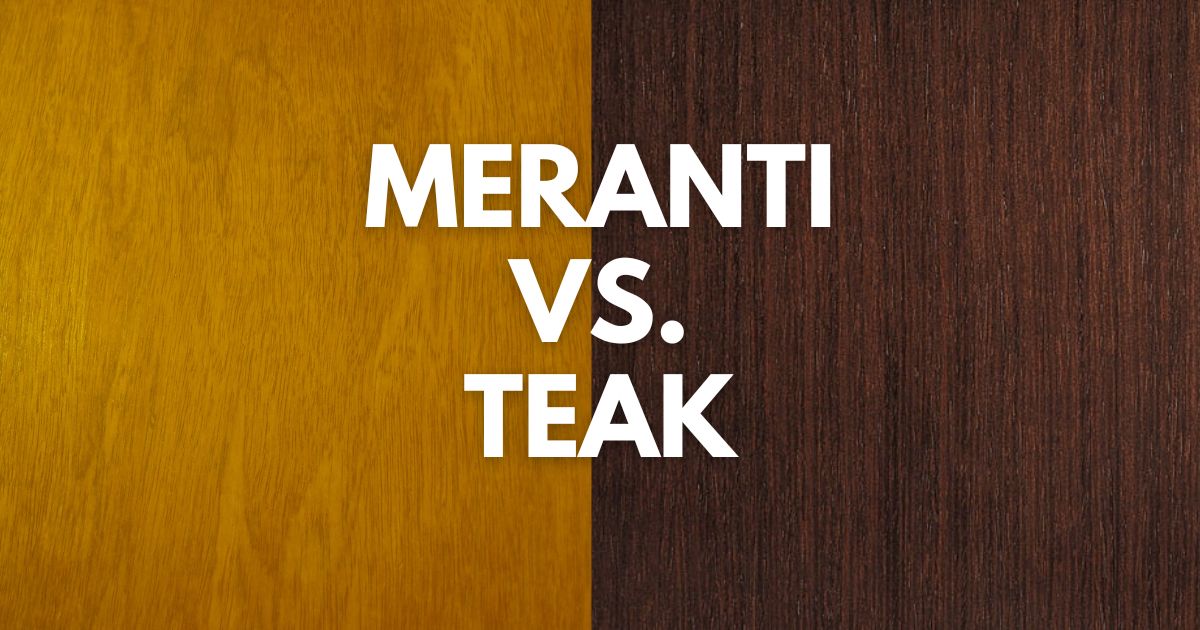Teak wood is more durable and rot-resistant than Meranti wood. Meranti wood is also considered a durable hardwood but is less resistant to decay and insects than Teak Wood. Teak wood is more suitable for furniture or outdoor projects than Meranti wood.
Teak wood comes from the Tectona grandis tree species, the family Lamiaceae. Meranti wood comes from the Shore genus species.
Teak is the fastest-growing tropical hardwood. It takes 20 to 25 years to be ready for harvesting. The Meranti tree takes 50 years to reach a height of 40-50 meters.
Meranti Wood
Meranti is a moderately durable, hard, and versatile hardwood native to Southeast Asia and the Pacific Islands. It is a popular choice for construction and furniture projects.
Meranti wood is a common name for several species. Some popular species are Red Meranti, White meranti, and yellow meranti. Each species has unique characteristics, but they share some common properties.
Teak Wood
Teak is an extremely durable, stable, and dense hardwood native to the south and southeast regions of Asia, including India, Indonesia, Malaysia, and Myanmar (formerly Burma).
It is a highly prized wood because of its natural properties and golden-brown to dark-brown color. Teak wood is one of the best durable woods; it requires less care than other hardwoods.
There are many species of Teak wood. Some popular species are as follows: Burma Teak, Burmese teak, Indonesian teak, Indian teak, African teak, and many more.
| # | Meranti Wood | Teak Wood |
| Scientific name | Shorea spp. | Tectona grandis |
| Tree Size | 65-130 ft (20-40 m) tall, 3-6 ft (1-2 m) trunk diameter | 100-130 ft (30-40 m) tall, 3-5 ft (1-1.5 m) trunk diameter |
| Hardness | Moderate hard | Harder than Teak wood |
| Workability | Easy to work | Easy to work |
| Rot resistant | Very Rot resistant | Moderately |
| Type | Hardwood | Hardwood |
Uses
Meranti wood is mainly used for interior furniture, plywood, veneer, and boat building. It is not recommended to use Meranti wood for outdoor purposes as it is not weather and moisture-resistant as teak wood.
Teak wood is one of the most popular and versatile choices for boat-building, plywood, veneer, exterior and interior furniture, carving, turnings, and small wooden objects.
Teak wood is used for musical instruments. It is used to make Thailand’s traditional wooden xylophone, especially for parts that require power, stability, and resonance.
Appearance
Teak wood can range from golden brown to dark brown with a straight grain pattern. It has a distinctive and elegant appearance with a fine texture
On the other hand, meranti wood can vary from light pinkish-brown to dark reddish-brown. It usually has a coarse texture with medium to large pores.
The color of Meranti wood and Teak wood depends on its species. Like other hardwoods, it also darkens over time when exposed to UV light and air.
Workability
Meranti and teak wood are easy to work with hand and machine tools. Due to the high density and silica in teak, the planing can be difficult. The silica creates a blunting effect on cutting edges.
Although silica is also present in meranti wood, it is much less than teak. Meranti wood has very poor steam-bending properties but glues, stains, and finishes well.
Use sharp tools while working with Meranti and Teak wood. Both kinds of wood give excellent results after finishing.
Hardness
Generally, the hardness of Teak is more than that of Meranti. Teak wood has a Janka hardness of 1,070 lb (4,740 N), while Dark Red Meranti has a hardness of 800 lb (3,570 N).
But we should know that Teak and Meranti wood’s hardness varies from species to species. For example, the hardness of White Meranti is 1,050 lb (4,670 N), and Light Red Meranti is 550 lb (2,460 N).
Durability: Meranti Wood vs Teak Wood
Teak wood is more durable and stable than Meranti wood because it contains natural oils (silica), making it more resistant to moisture, weathering, and fungal attack. Meranti is moderately durable and may require proper treatment or finishes for outdoor applications.
Which is more water resistant? Meranti Wood or Teak Wood
Teak wood is more water-resistant than Meranti wood because of the high content of silica. Silica is a natural oil formed during the tree’s growth. Due to silica, the surface of teak wood becomes oily, which protects the wood from moisture or insects.
In those woods that do not contain natural oil, we create temporary layers by properly sealing. Which makes the wood moisture-resistant for a while.

